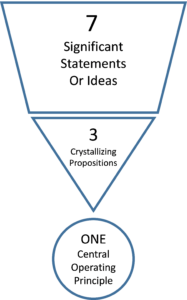
Fast Track Thinking – Upside down, Inside Out, Downside Up
What’s really wonderful about the Fast Track Thinking app is that it serves to align a relationship between three kinds of information. In the case of Fast Track Thinking, that relationship is not linear and sequential – where one flows from the other – but dynamic, where any one can lead to the other two.
You can start the Fast Track Thinking process at any point – at any of the three levels.
Suppose you have already intuited a Big Idea… because that’s just the way you are gifted to think (in which case you clearly are a fast thinker and fundamentally creative? If that’s enough for you then all is good.
On the other hand, if you are driven to understand the WHY behind such serendipitous cogitation so that you can be sure it keeps happening again and again (as was the case in my experience) then it can’t hurt to build the complete picture, regardless of whether you start at the top and work your way down, start at the bottom and work your way up, or start in the middle and work up and down from there.
The point is that the framework helps you combine intuition and logic into the most productive amalgam of thinking possible. As you practice and perfect your working with this “app” you will internalize the dynamic – and that is what Fast Track Thinking is all about.
Questions Matter More Than Answers
The fundamental premise behind Fast Track Thinking is discovering and implementing the best framework that will help shape thinking more rapidly and more effectively. In a sense, that framework is a kind of “fill in these blanks” exercise.
The methodology knows what to ask but can’t know what your answers should be. Fast Track Thinking poses the questions but only you can provide the best answers for you.
Knowing what questions need to be asked gets the thinking started. The Fast Track Thinking framework focuses the brain on the specific type and number of questions and, more importantly, on the best path to progress. Remember that FTT got its start when I realized that I might not have the answers… nor even the questions… in any meeting, I did at least know there needed to be three propositions that framed the issue to be determined and that the group needed neither more nor fewer than seven significant facts to get the job done.
Which gets to the heart of the best type of thinking. The truth is that answers are not nearly as important as questions. After all is said and done, answers can’t even exist until the questions have been asked. Getting the right answer totally depends on asking the right question. A framework IS a question; actually a whole stream of directed questions.
At its heart, Fast Track Thinking is built around the understanding that what focuses the human brain for optimum performance is knowing what questions to ask is the best kick start towards getting the answers. That, and knowing that the key to unlocking understanding is marked by the process of distillation and crystallization.
Download Article

















